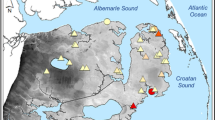Abstract
Based on periodic soil salinity measurements direct gradient analysis procedures were used to relate the performance and distribution of mangrove swamp species to salinity gradients. Variations in soil salinity were due to distance from the coast, tidal incursions and freshwater inputs. All overstorey species showed statistically significant negative correlations with salinity while most groundlayer species were positively correlated with the same factor. Based on ecological group classification, no species was found to occur on the highest values of soil salinity. There were overlapping range of occurrences and ecological optima for most species along the gradients.
Similar content being viewed by others
References
Adams, C. D. 1963. Factors influencing vascular plant zonation in North Carolina salt marshes. Ecology 45: 479–494.
Chapman, V. J. 1976. Mangrove Vegetation. J. Cramer Publ. Co., Vaduz.
Cintron, G., Lugo, A. E., Pool, D. J. & Morris, G. 1978. Mangroves of arid environments in Puerto Rico and adjacent islands. Biotropica 10: 110–121.
Fagbami, A. A., Udo, E. J. & Odu, C. T. I. 1988. Vegetation damage in an oil field in the Niger Delta of Nigeria. J. Trop. Ecol. 4: 61–75.
Giglioli, M. E. C. & Thornton, I. 1965. The mangrove swamps of Keneba, Lower Gambia River Basin 1. Descriptive notes on climate, the mangrove swamps and the physical composition of their soils. J. App. Ecol. 2: 81–104.
Good, R. E. 1972. Salt marsh production and salinity. Bull. Ecol. Soc. Amer. 53: 22 (abstract).
Jackson, G. 1964. Notes on West African vegetation 1. Mangrove vegetation at Ikorodu, Western Nigeria. West Afri. Sci. Assoc. J. 9: 98–111.
Keay, R. W. 1953. Rhizophora in West Africa. Kew Bull. 1: 121–127.
Lugo A. E. 1980. Mangrove ecosystems: successional or steady state? In: Tropical succession. Biotropica 65–72.
Mueller-Dombois, D. & Ellenberg, H. 1974. Aims and methods of vegetation ecology. J. Wiley, London.
Savory, H. J. 1953. A note on the ecology of Rhizophora in Nigeria. Kew Bull. 1: 127–128.
Walsh, G. E. 1974. Mangroves: A review. In R., Reimold & H., Queen (eds.) Ecology of halophytes. pp. 51–174. Academic Press, New York.
Waring, R. H. & Major, J. 1964. Some vegetation of the California coastal redwood region in relation to gradients of moisture, nutrients, light and temperature. Ecol. Monogr. 34: 167–215.
Whittaker, R. H. 1967. Gradient analysis of vegetation. Biol. Rev. 49: 207–264.
Whittaker, R. H. 1978. Direct gradient analysis. In: R. H., Whittaker (ed.). Ordination of plant communities. Handbook of vegetation science 5. Dr W. Junk, The Hague.
Author information
Authors and Affiliations
Rights and permissions
About this article
Cite this article
Ukpong, I.E. The performance and distribution of species along soil salinity gradients of mangrove swamps in southeastern Nigeria. Vegetatio 95, 63–70 (1991). https://doi.org/10.1007/BF00124954
Accepted:
Issue Date:
DOI: https://doi.org/10.1007/BF00124954




